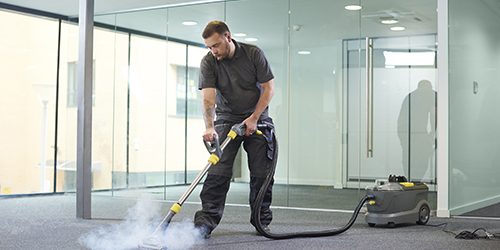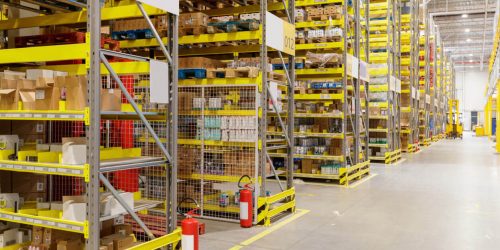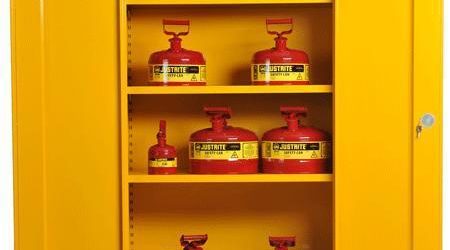Purchasing guide: Choosing the right fire protection equipment
With an increasing frequency of natural disasters, companies need to have the necessary fire protection equipment on site to ensure people’s safety. This equipment covers risks such as fires, but also droughts and floods. Take stock of your equipment and follow our advice by browsing our dedicated guide.
How can you prepare your business for climate disasters?
Employers are responsible for the health and safety of all their employees. They must establish a safety culture in the workplace, which involves informing the teams about risks and training them in the use of safety equipment. Workplace safety policies are based on risk assessment, followed by measures to control these risks as much as possible.
When risks persist, safety equipment is put in place:
- Collective protection equipment (CPE), which secures a work area;
- Personal protective equipment (PPE), worn directly by employees.
Lastly, beyond measures to eliminate risks, quality of work life policies aim to improve the physical and mental health of employees.
According to a recent report by the Intergovernmental Panel on Climate Change (IPCC), global surface temperatures have increased by 1.1 °C since the pre-industrial period. This rise is expected to reach 1.5 °C by the 2030s.
The same report states that, driven by climate change, the number of climate disasters is expected to continue to increase. It is therefore essential for society as a whole to prepare for climate disasters, such as forest fires caused by drought and heatwaves or floods.
What measures can you take in case of a fire in your company?
In the specific case of fire risk, the measures put in place should follow three objectives:
- Evacuating the premises;
- Alerting emergency services as quickly as possible;
- Carrying out the rescue of people in danger.
In the event of a fire, it is possible to take action during the first two minutes. During this period, the fire is considered controllable. It is then possible to try to extinguish it using fire safety equipment such as fire extinguishers, fire blankets, or sand.
If the fire persists beyond three minutes, it is then necessary to proceed with the evacuation of the premises. People present on site are alerted by the smoke detector and asked to evacuate following the indications of the safety signs provided for this purpose. External emergency services must simultaneously be called. They then intervene to extinguish the fire and rescue people in danger.
Choosing your essential fire protection equipment
When selecting your fire protection equipment, start with the devices that allow for rapid control of the flames. Fire extinguishers are the first piece of equipment to use in order to fight the fire. They allow for swift action, without external intervention, provided the right extinguisher is available and well-maintained. Smoke detectors are an excellent complement since they raise the alarm during a fire or a gas leak for a quick response.
Fire extinguishers adapted to the type of risk
Company premises must be fitted with fire extinguishers to make sure a rapid response is possible should a fire break out. These fire extinguishers should bear the CE marking, proving they have undergone necessary pressure risk tests before being put on the market.
Professionals should also be aware that fire extinguishers have a shelf life and that they should be regularly inspected. The frequency of these checks depends on the type of fire extinguisher.
There are four types of fire extinguishers:
- Water fire extinguishers are used for Class A fires, caused by flammable materials like fabrics, wood, paper;
- Fire extinguishers with additives, like foam fire extinguishers, are water-based and used under the same circumstances as water fire extinguishers, while also working on Class B fires which are related to flammable liquids (e.g., paint, petrol);
- Dry powder fire extinguishers apply to Class A and B fires, as well as Class C fires which are connected to flammable gases;
- CO2 extinguishers (carbon dioxide), which smother the fire by replacing a portion of the oxygen with CO2, are used on electrical fires and Class B fires.
Fire extinguishers should not be left on the floor to prevent them from rusting or being knocked over (by trolleys, for instance). Therefore, it is crucial to think about acquiring fire extinguisher brackets or cabinets to mount them high up. Finally, they should be easily accessible and visible.
Smoke detectors
Installing smoke detectors in company premises is not compulsory in all European Union countries. Nonetheless, this type of fire safety equipment enhances reactivity by raising the alarm rapidly in the case of a fire.
There are several types of smoke detectors. Autonomous smoke detectors must bear the CE marking and comply with the EN 14 604 standard. This European standard certifies that the fire protection product meets safety regulations.
Carbon monoxide detectors should also be CE certified, and they should comply with the EN 50 291 standard. Another European standard, it sets the thresholds for triggering the alarm, depending on the level of carbon monoxide concentration.
Lastly, there are combined detectors, which provide both features, smoke detection and carbon monoxide detection.
Other fire protection equipment and accessories
Companies can choose from a variety of other fire protection equipment and accessories to implement an effective risk prevention policy.
Emergency lighting and safety signs aim to inform about evacuation rules, indicating emergency exits and assembly points.
Fire hoses are used during the intervention of the fire brigade. These two categories comply with European standards when it comes to fire prevention.
Fire blankets are suitable for small fires. Simply place them on the flames to smother them.
Smoke detectors are usually connected to the company’s overall alarm system. All public buildings must be equipped with a smoke detectors.
Sand boxes are used to store sand for instances where spilled petrol may catch fire. The sand is meant to be spread on the floor in the presence of petrol to absorb it and prevent it from igniting. Sand can also be scattered directly onto a fire while waiting for emergency services. This type of box needs to be installed in a risk area and equipped with a shovel.
Fire doors close automatically in the event of a fire to prevent its spread. They should be accompanied by electromagnetic wall clamps designed to keep the doors closed. Fire doors comply with European Regulation EN 1634-1. Legislation also requires safe storage of hazardous products. Safety cabinets meet this requirement. These cabinets are equipped with automatic locking and sealing systems when a fire is detected nearby.
Finally, fireproof bins are another useful accessory for fighting fires. Their system prevents air from coming in to avoid igniting their content.
Flame-retardant clothing
Flame-retardant workwear is classified according to two standards. Clothing for protection against flames or limited flame spread is governed by international standard ISO 14116, giving protection against short and occasional contacts with small flames.
Clothing for protection against heat and flames is regulated by international standard EN ISO 11612. As the name suggests, these pieces of clothing protect against risks such as heat and flames. They protect users against radiant heat or splatters of molten metal. Clothing for welders and protection against forest fires fall into this category.
Please note that these clothing items don’t fully protect against fire but have a retardant effect. The aim is to provide protection in an environment presenting risks related to burns.
Making the right choices for drought and flood equipment
To prevent water shortages due to drought, companies can equip themselves with water retention tanks. This type of container allows the reuse of collected rainwater for the watering of green spaces, for example.
Flood prevention tubes are used to block rising waters. They are placed in front of doors to absorb water and prevent it from entering the premises. These pieces of equipment are easy to set up and durable. Some are reusable and come in several lengths and absorption capacities.
Take advantage of safety innovations in the workplace and choose your fire protection equipment by exploring our range of “Fire protection equipment” products.




